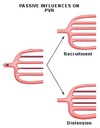Case 5 - Resporatory Flashcards
How do you calculate alveolar ventilation?
= (tidal volume - dead space volume) X respiratory rate = (500 - 150) X 12 = 4200 ml/min
How is V:Q ratio defended and controlled locally?
A little air flow and large blood flow will cause 1) CO2 to dilate airways to increase airflow 2) O2 to vasodilate pulmonary vessels to decrease blood flow See case 5 notes as well as diagram from sherwood.
How is the respiratory centre controlled
See diagram in case 5 notes
What is the role of the Dorsal Repsiratory Group in breathing?
1) Contains mostly inspiratory neurones terminating at inspiratory muscles 2) firing initiates inspirating, inspiratory muscle relax when firing stops
Where the location of the pneumotaxic and apneustic centres and what do they do?
Pneumotaxic centre - sends impulses to DRG to help switchin off firing and thus preventing inspiration Apneustic centre - prevents switching off of inspiratory firing, boosts inspiration
What is the function of the pre-Botzinger complex?
Generation of respiratory rhythm - display pacemaker activity (self-induced action potentials)
You are interpreting an arterial blood gas. What are the normal values of pO2? pCO2? pH?
pO2 - 75-100 mmHg pCO2 - 35-45 mmHg Normal pH - 7.35 - 7.45
What is the average pulmonary ventilation and how is it calculated?
Pulmonary ventilation = 6000 ml/min = 500 ml/ min X 12 breaths = tidal volume x resp. Rate
What is the function the the pulmonary circulation?
1) to bring deoxygenated venous blood into contact with alveoli BUT ALSO to.. 2) protect the body from thrombi/emboli 3) metabolism of vasoactive substances - angiotensin | to angiotensin || 4) blood reservoir mobilised in shocked states
What do the pulmonary arteries do once they reach the lung?
Branch to form a dense capillary network to facilitate gas exchange
What are the features of pulmonary capillaries?
- Low pressure (25/8) unlike in systemic where pressure in aorta is 100 mm Hg
- Low resistance
- forms a mesh capillary network allowing blood to flow as a single sheet
- thin walls, adding to low pressure, right ventricle pressure exceeds that of pulmonary artery quickly - minimum work is needed to pump blood to pulmonary artery
What are the features of pulmonary arteries and arterioles? What makes them different to systemic arteries?
- Carry deoxygenated blood
- Less elastin and less smooth muscle
- thinner walls that arta
- all in all, they are less able to constrict that systemic arteries
What are the regional differences in perfusion and ventilation in the lung?

Describe the zones of the lungs in terms or arterial (Pa) and alveolar (PA) pressure.
- The further you go down the lugs, the more perfused the alveoli are
- thus Pa increases as you go further down the lungs and exceeds alveolar pressure, allowing more gas exchange to take place

- what is the normal value of alveolar ventilation?
- What is the normal ventilation:perfusion ratio in healthy individuals?
- Tidal volume - dead space X respiratory rate = 500-150 x 12 = 4200 ml (can be between 4 to 6 litres)
- As close to 1 as possible, so between 0.8 and 1.2








